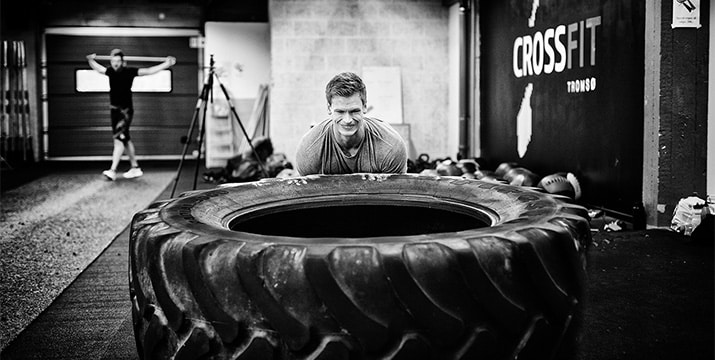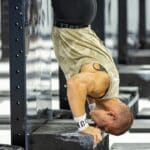Ahh – the gut. That pesky garden hose-esque tube that travels through your body and can make or break just about any big workout or competition, no matter what your fitness levels are. Many a physically superior human being has had a WOD derailed by excessive toilet time or a Dumb & Dumber style poo moment caused by a complete rebellion of the tube.
Fact is, there are some things that you simply shouldn’t eat before you’re about to go ask your body to perform at the highest level. Some of these will directly decrease performance by creating bloating and gas, or by drawing precious blood away from your muscles and into your gut.
And there are some things that will allow you to perform just fine, but make you feel like crap after you’re done – or that night, or the next day, or a decade later after your gut, digestive tract lining and microvilli are destroyed by years of cumulative unhealthy fueling and digestive stress.
Finally, there are of course some things that are potent ergogenic, performance-enhancing aids that will give you all the energy you need for your workout, maximize post-workout recovery speed, and completely save you from decommissioning any bathrooms.
So in this article, you’re going to conquer your gut with 10 workout nutrition do’s and don’ts that will help you to navigate the oft-confusing world of workout fueling.
Jump to:
- 1. Don’t include FODMAPs such fructose and maltodextrin.
- 2. Don’t include the high amounts of caffeine recommended in sports nutrition literature.
- 3. Don’t include artificial sweeteners
- 4. Don’t include high amounts of fiber.
- 5. Don’t include heavy, non-portable foods.
- 6. Do juice.
- 7. Do include moderated amounts of caffeine.
- 8. Do eat easy-to-digest carbohydrates.
- 9. Do eat easy-to-digest fats.
- 10. Do eat easy-to-digest proteins.
- Summary
1. Don’t include FODMAPs such fructose and maltodextrin.
FODMAPs are short chain carbohydrates called oligosaccharides and other simpler carbohydrates called disaccharides and monosaccharides, along with sugar-related alcohols that are poorly absorbed in the small intestine. In many, many athletes, FODMAP’s can be one of the leading causes of GI distress, gas, bloating, diarrhea, constipation and something called “gut rot” (pleasant term, eh?) – especially if you eat a bunch of them before you exercise or race. Examples of FODMAP’s I see lots of athletes including in pre-workout meals include organic dairy (lactose), fermentable stone fruits, like apples and pears, fermentable vegetables like cauliflower and broccoli, and yes – sad face – even dark chocolate. Many popular sports nutrition bars and powders also include big doses of fructose, sugar alcohols like xylitol or polyl, or maltodextrin. None of these are a good idea pre-workout, especially if you have a sensitive stomach or tend to easily get gas and bloating.
2. Don’t include the high amounts of caffeine recommended in sports nutrition literature.
Yes, caffeine can enhance sports performance. That horse has been kicked to death. But that doesn’t mean more is better – especially if you’re concerned about your long term adrenal health or the chances of overworking your central nervous system.
Most recommendations you’ll find in sports nutrition literature tell you to eat are about 0.5–1.5 mg caffeine per pound of body weight (that’s about 1–3 mg per kg). For a 150-lb (68-kg) athlete, that’s a dose of 70–210 mg of caffeine. But I recommend you choose the minimum amount possible, because when caffeine intake gets too high or goes on for too long, there is an increase in side effects like jitteriness, nervousness, insomnia, headache, dizziness, and gastrointestinal distress, all of which can impair your athletic performance or cause long term adrenal issues. Most athletes still get ergogenic benefits from as little as 75mg of caffeine, which is a drop in the bucket compared to what many pre-workout blends and capsules contain, and you’ll learn more about how to calculate the correct caffeine dose for you later in this article.
3. Don’t include artificial sweeteners
One common artificial sweetener found in sports nutrition supplements is sugar alcohol – which is one of the FODMAPs mentioned earlier. Another common one is sucralose, which may damage the good bacteria in your GI tract. Many others, such as aspartame and acesulfame potassium can be neurotoxic, and can cause brain fog or fuzzy thinking while you’re exercising – not something you want to have happening when a barbell is overhead. So I highly recommend you avoid just about any low-calorie sweetener except stevia prior to exercise. You’ll be surprised once you begin inspecting labels at how many sports nutrition fuels actually include the stuff, and even many “Paleo-approved” fuels still contain high amounts of sugar alcohols or honey-derived fructose.
4. Don’t include high amounts of fiber.
Fiber is not only primarily digested in your colon, but it also significantly slows gastric emptying, so consuming too much fiber before a workout simply results in a lot of undigested food bulk in your stomach and intestine. Big bowls of pre-workout or pre-race fiber enriched fruit-based bars, fruit smoothies, kale shakes or nutrition compounds with ingredients like inulin or psyllium can cause some serious issues, especially for long workouts – so be careful. While it’s true that juicing can help you get concentrated amounts of the phytonutrients, antioxidants and flavonols without requesting as much work from your digestive system, you’re still usually going to get concentrated sources of fructose when you juice. If you’re curious where blending fits in, then keep reading.
5. Don’t include heavy, non-portable foods.
So perhaps you’ve jumped on the real food bandwagon hardcore, and you’re prepping for workouts by wrapping giant sweet potatoes in aluminum foil, chopping steak to put into a ziplock bag, and grabbing enormous handfuls of seeds and nuts to bring to the gym. I personally think this is silly, and if time management, workout speed and extreme portability are high priority for you then giant sweet potatoes, bananas, water-filled fruits, and melted dark chocolate bars are not a great solution. There are right ways to consume real food-esque foods during your workout (which you’re about to learn). But there are also wrong ways to consume real food during your workout – and if something is big, bulky, heavy or takes a long time to prep, it can inhibit your efficiency and your aerodynamics, and even increase decision-making fatigue, which can detract from your workout. Keep things simple, clean and light.
6. Do juice.
Huh? Didn’t I just say not to juice? I partially lied. See, when you blend or juice foods, you do in fact make things much easier on your digestive system, allow foods to empty more quickly from the stomach. Blending or juicing also helps to pre-digest the food so your body doesn’t have to work as hard during digestion. This frees up precious energy for you to be able to devote to breathing, moving and contracting muscles. Cell walls are broken down and nutrients are quickly released (especially from greens like kale, or dark root vegetables like beets and carrots.) When you use these strategies, you’re essential “chewing” your food much more thoroughly than you may have been able to with your teeth, and many foods that would normally have given you digestive trouble – such as a bunch of carrots or a big spinach salad – will digest just fine when blended or juiced.
For optimum blending or juicing efficiency, don’t mess around with the baby blenders. I recommend a high-speed quality blender (think Vitamix-type size) and a masticating juicer. Two of my “go-to” recipes for pre-workouts are a kale smoothie blended with 20-30g protein powder and 4-6oz coconut milk, or a carrot-cilantro-ginger-lemon juice with a touch of olive oil and sea salt added in post-juicing.
7. Do include moderated amounts of caffeine.
As you learned earlier, caffeine can definitely help with sports performance. As a matter of fact, 1,3,7-trimethylxanthine, more popularly known as caffeine, is the world’s most consumed natural pharmacological agent. Caffeine has been shown to improve endurance and time trial performance in cyclists, increase endurance in runners, and improve performance times and boost power in rowers. Caffeine has also been shown to improve performance in cycling and running events lasting 5 minutes or more, and to increase power output, speed, and strength in sprint and power events lasting less than 10 seconds (incidentally, caffeine has been shown to have no effect, and may even be a negative factor, in sprint and power events lasting anywhere from 15 seconds to 3 minutes)
In tennis players, caffeine increases hitting accuracy, speed and agility, and overall success on the court. And players reported feeling more energy late in their matches. Caffeine also reduces your “rating of perceived exertion”, or how hard you feel like you’re actually working – which essentially causes you to push harder and faster.
Unfortunately, most folks are averaging about 238 mg of caffeine every day — which is the equivalent of 2–3 cups of coffee – and 20–30% of people consume a whopping 600 mg of caffeine daily (with about 71% of it coffee, 16% from tea, and 12% from soft drinks and energy drinks). And as you learned earlier, when you shove high amounts of caffeine into our system prior to a workout, it’s simply extra stress on your adrenal glands. The minimum effective dose of caffeine is about 0.5mg per pound of body weight (1mg per kg of body weight). For a 150lb athlete that’s the equivalent of a small cup of coffee.
8. Do eat easy-to-digest carbohydrates.
White potato, sweet potato, yam, taro and white rice are the top five carbohydrate sources that seem to be best tolerated by athletes prior to hard workouts. But how much do you actually need?
Let’s say you wake up on workout morning. You’ve primarily burnt through your liver’s glycogen stores while sleeping. The average human needs (at most) about 400 calories of carbohydrate to completely top off those stores (assuming you haven’t been starving yourself, your muscles are already full of glycogen and ready to rumble). So if you eat 100 grams from any of the starch sources mentioned above, that’s all you’d need to top of liver glycogen stores for a hard workout (400 calories of carbohydrate is far less than the commonly recommended pre-workout values of anywhere from 600-1500 calories!). To put that number into context, that’s about 2 cups of cooked white rice, or a couple large, boiled sweet potatoes or yams. Liberally add sea salt to either of the foods above, throw in a few tablespoons of the healthy fats and proteins you’ll learn about momentarily, allow 1.5-2 hours for gastric emptying, and you have a pre-big workout meal.
However, if you’ve been adhering to a high-fat diet or a ketogenic diet, you’ll need even fewer carbohydrates than this, and for your pre-workout, you can simply get away with the minimum amount of carbohydrate necessary to keep your brain’s neurons firing so that you don’t lose mental function. This comes out to about 30 grams, or 120 calories of carbohydrate. Because ketosis produces this state of fat-utilizing metabolic efficiency, most of the athletes I’ve worked with (including myself) who are implementing ketosis go into their big workout or race with a pre-event meal of Bulletproof Coffee, or a high fat shake prepared with nuts and coconut milk, or 1-2 servings of a slow release starch such as UCAN Superstarch with coconut milk (more on Superstarch later).
By the way, some folks worry about brain bonking when exercising in a state of ketosis, but you actually don’t need to worry about neural fatigue from your brain running out of fuel. Here’s why: once you begin exercising, your brain will draw upon lactic acid as a source of energy. (your brain actually prefers to burn lactic acid and ketones more than glucose), along with glucose derived from amino acids (gluconeogenesis), and glucose derived from muscle and liver glycogenolysis.
9. Do eat easy-to-digest fats.
In contrast to fats that take a long time to digest, such as eggs, bacon, cheese or yogurt, medium chain triglycerides from sources such as MCT oil, coconut oil, or coconut manna (look it up, it’s like solid ambrosia) mostly bypass the normal process of digestion and instead get absorbed directly into your liver, where they can then be metabolized to provide a quick source of energy. This makes MCT oil in particular a valuable addition to your “before” meal. For joint and heart health, you can also include small amounts of a concentrated source of anti-inflammatory omega-3 essential fatty acids from a cold-press plant-based oil such as extra virgin olive oil, avocado oil, or brands such as Udo’s oil or Panaseeda oil.
10. Do eat easy-to-digest proteins.
Like many fats, proteins also take a long time to digest and require lots of energy to break down – which is why a pre-race meal of steak and eggs is a recipe for gut disaster or sub-par performance. But the amino acids derived from proteins can come in quite handy for efforts of greater than 3 hours in duration, since during these long efforts your body can use up to 15% of it’s energy requirements from protein. In addition, high blood levels of amino acid during exercise can lower your rating of perceived exertion, can stave of muscle self- cannibalization, can compete for tryptophan and in your brain and prevent you from getting workout “sleepiness”, and significantly decrease post-exercise soreness.
For this reason, I recommend that prior to your big workout you include any or all of the following: A) 20-30 grams of a hydrolyzed whey protein, which is a type of “pre-digested” protein that is more expensive, but much easier to absorb and assimilate compared to regular whey protein; B) 5-10 grams of essential amino acids, which have an extremely high absorption rate (you can find these in capsule or powder form, typically abbreviated “EAA’s” rather than the more common and less effective “BCAA’s”; C) 10-20 grams of a hydrolyzed collagen protein source from an organic, clean powder such as Great Lakes or Bernard Jensen brand (or simply drink a cup of bone broth with your pre-workout meal. Compared to eating a steak, these type of protein sources are far less stressful for your digestive system to break down and absorb. Remember – you don’t want to be making your gut work any harder than it needs to.
Summary
Whew. That may seem like a lot of rules to follow. So if you’re confused, simply A) read again to cement your new-found knowledge and B) step back and think about the major goal: provide easy-to-digest, quickly absorbed carbohydrates, proteins and fats while avoiding anything that has potential for fermentation, bulk or excessive nervous system stimulation. Once you look at things in that light, a simple yes or no answer becomes easy.
Salad? No. Taking the salad and blending it? Yes. Energy drink? Check label. If caffeine, fructose, etc primary ingredients, then no. If amino acids, electrolytes, etc., then yes. Energy bar. Check label. If high amount of fruit based compounds, sugar alcohols, chocolates, etc. then no. If ingredients such as coconut oil, chia, hemp protein, etc. then yes.
You get the idea. Venture into the world of workout nutrition with this list, and you’ll be well on your way to avoiding the toilet, beating the bloating, and conquering your gut.













